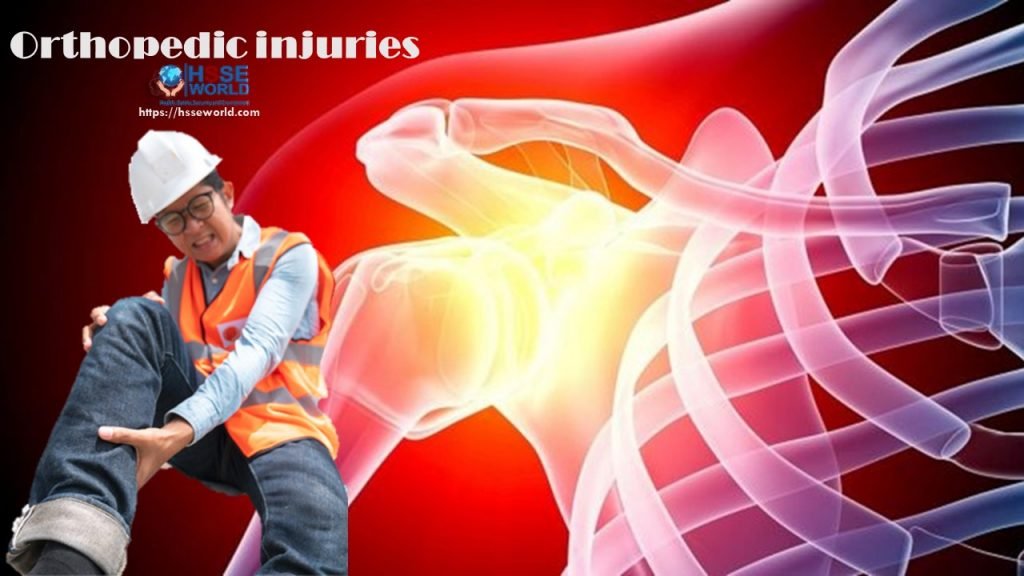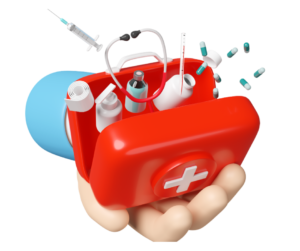Common Orthopedic Injuries at Work
8 min readAccidents can happen anytime and anywhere. Even people with cozy desk jobs aren’t safe from workplace injuries.
While it’s true that those working in construction, manufacturing, and other labor-intensive industries are at greater risk, everyone’s in danger of orthopedic injuries regardless of workplace or job title.

Common Orthopedic Injuries at Work
Awareness is the first step to prevention. With that in mind, let’s take a look at some of the common orthopedic injuries that are sustained at work.
Overexertion Injuries
Overexertion is the cause of many common workplace injuries, particularly among those whose roles involve plenty of physical labor. These injuries occur when the body is pushed beyond its physical limits, often due to constant lifting, carrying, pulling, or pushing.
Professions that are prone to overexertion injuries include construction workers, warehouse workers, movers, garbage collectors, and truck drivers. But while some industries are at higher risk for overexertion injuries, just about any employee can overexert themselves.
The following orthopedic injuries are commonly caused or associated with overexertion:
- Muscle strain: Employees who overexert themselves when lifting, carrying, or moving objects tend to suffer from pulled or strained muscles. These injuries might not seem very serious, but they can keep employees from performing their jobs properly.
- Back injuries: Most back injuries, like mild strains, can be treated with rest and anti-inflammatory medicine, but more severe injuries might require surgery or physical therapy.
- Joint and connective tissue injuries: The majority of workers have suffered from a tendon tear, a dislocated joint, or a swollen connective tissue at some point in their careers. Joints, tendons, and connective tissues are put to work any time physical work is performed, which makes them prone to overexertion.
Overexertion injuries are often acute, but they can get worse if they’re ignored for too long. It’s vital to treat the injury and ensure ample recovery time before returning to the tasks that caused them.
Repetitive Motion Injuries
Repetitive motion injuries, or repetitive strain injuries, are injuries to the muscles, tendons, and ligaments caused by doing the same motions repeatedly.
Many jobs require repetitive motion to accomplish. Everyday tasks like typing or lifting, when performed for hours on end daily, can cause strain on the muscles and tendons, eventually leading to injury.
Employees who spend all day behind a desk might be the last people you would expect to get injured on the job, but they’re actually at risk of carpal tunnel syndrome. Those who work in the heavy-labor industry can also get repetitive stress injuries from lifting and tossing objects in the same direction.
Some common workplace orthopedic injuries that result from repetitive motion include:
- Carpal tunnel syndrome: This occurs when the median nerve, which travels from the forearm to the hand, becomes compressed by swollen or inflamed ligaments and tendons that surround it. Carpal tunnel syndrome is usually less apparent during the early stages but becomes more painful over time. Left untreated, it can develop into a long-term issue, and may even cause numbness and loss of motion, strength, and flexibility. (Read more: 9-tips-to-prevent-carpal-tunnel-syndrome/)
- Tendinitis: Tendons connect the muscles to the bones and they can get inflamed or injured through the course of performing repetitive movements. Tendinitis is one of the most common forms or repetitive stress injuries, and it can affect many different parts of the body. Most employees, particularly those who have been working in construction or the assembly line for years, are at risk of developing tendonitis.
- Bursitis: Another widespread repetitive stress injury in the workplace is bursitis, which is the swelling of the bursa (the small, fluid-filled sacs that serve as a cushion between the bone and muscles, tendons, or skin). This condition is typically caused by placing repetitive and constant pressure on the joints and is characterized by pain, tenderness, and swelling around the affected joint.
- Rotator cuff injuries: Rotator cuff injuries are commonplace in many occupations that involve repetitive overhead lifting and reaching. Like many repetitive motion injuries, it also takes time to develop. It starts off as a subtle pain but becomes more apparent over time. Rotator cuff injuries can be either partial tears or complete tears. People who have rotator cuff injury experience pain with arm movement and often have a hard time lifting the affected arm.
Reaction Injuries
Our muscles tighten up when we react to unexpected situations, which increases the chance of injury. A worker who loses balance while going down the stairs and tries to steady himself with a jerk may end up with pulled muscle or – worse – broken bones.
One of the most prevalent physical reaction injuries in the workplace is trauma without impact. Sudden reactions caused by slipping, tripping, bending, reaching or climbing can result in a number of orthopedic injuries, including whiplash, meniscus tear, strained neck, or pulled back muscle.
The thing is, it sometimes takes days for many people to realize that they have suffered from a reaction injury, especially if the trauma isn’t obvious. Because of this, many workers keep working despite the injury and end up aggravating the damage.
Some accidents can’t be helped, but many reaction injuries can be prevented by keeping the workplace clean and tidy and paying attention to your surroundings at all times.
Most workplace orthopedic injuries start off as mild discomfort, but they get worse the longer treatment is delayed. Many of these conditions can be treated with rest, ice, and anti-inflammatory medicine, and by modifying work techniques to prevent further injury. However, if the pain and loss of function are already limiting the person’s range of motion, seeking medical help is strongly advised.
(Find out workplace wellness initiatives to improve workplace safety )
Virtual Triage and Remote Care for Orthopedic Injuries
Ideally, every workplace should have an in-house physician or medically-trained safety office that can perform on-site triage every time an accident occurs. Since not all businesses can afford their own medical personnel, injured employees are often sent to the emergency room.
But as not all injuries warrant a trip to the ER, ending up in the emergency room over a sprain or pulled muscle seems to be overkill. For many workplaces, telemedicine can provide a fast, convenient, and much more affordable method of handling orthopedic injuries.
Keep in mind, though, that telemedicine is not the appropriate response for serious injuries. Also, some employees may ask to receive medical care at a healthcare facility, even when telemedicine is an option.
The RICE Method
Health professionals recommend the RICE method for the early treatment of bone and soft tissue injuries. The primary goal of this treatment method is to manage the pain and swelling as quickly as possible.
RICE is effective for healing minor musculoskeletal injuries such as sprains and strains and keeping more complex orthopedic injuries under control while waiting for further treatment
RICE treatment involves four steps:
1. Rest
Injured tissues need rest to heal. Without proper rest, the injury can get worse and recovery may take longer than necessary.
Those who sustain orthopedic injuries need a 24 to 48 hour rest period to keep pressure off the injury and prevent bruising and increased swelling. Doctors also advise the use of assistive devices or mobility aids to avoid putting on weight on the affected limb or joint.
2. Ice
Ice is a tried and tested tool for reducing the pain and swelling associated with acute injuries. This technique is most effective when applied every two to three hours during the first 48 hours of the injury.
Apply ice or a cold gel pack on the injured area for not more than 20 minutes at a time. When using ice, make sure to wrap it with a towel or some layer of material first to prevent frostbite.
3. Compression
Compression helps reduce the swelling of injured joints. It involves wrapping the affected area with an elastic bandage. Special boots, air casts, and splints may also be used for both support and compression, in accordance with the doctor’s advice.
Compressions should be snug but not too tight or it will interrupt blood circulation. If the skin below the wrap turns blue or feels throbbing, the wrap is probably too tight and needs to be loosened a bit.
4. Elevation
Raising the swollen or injured body part above the heart level will provide a downward path for draining fluid back to the heart, which may help reduce the pain, throbbing, and swelling.
The recommended elevation height is six to ten inches above the heart. If the injury is on the arm or leg, lay down and prop the injured limb on a pillow to elevate it.
When to Seek Medical Treatment
The RICE method can effectively treat most common acute orthopedic injuries, especially when combined with nonsteroidal anti-inflammatory medications (like ibuprofen or naproxen). However, if the pain and swelling don’t begin to ease after the first 48 hours, then it’s time to see an orthopedic doctor.
For serious injuries where there is obvious fracture, dislocation, or severe pain and swelling involved, don’t waste time and get professional orthopedic treatment right away. These cases often require emergency medical attention.
Treatment options for orthopedic injuries include the following.
Nonsurgical Treatments
Many orthopedic injuries can be treated with conservative, non-surgical approaches. Depending on the severity of the trauma, the attending physician may treat the injury with topical or oral medications, physical therapy, or external fixation methods involving the use of casts, braces, splints, and other devices to stabilize the affected body part and improve strength and movement.
Surgical Treatments
Surgical treatment options usually involve the use of internal fixation methods to attach screws, wires, plates, and other fasteners on the bone to stabilize it. Some severe orthopedic injuries may require more advanced surgical procedures like bone grafting or complex reconstruction to restore function and a full range of motion.
Rehabilitation
Physical therapy is often recommended post-surgery or after sustaining a severe bone or muscle injury to restore the affected limb or joint to its pre-injury condition.
Rehabilitation programs are designed to meet the needs of the individual patient.
Orthopedic physicians prescribe patients with a progressive plan for gradual healing. The length of recovery varies, again, depending on the severity and type of injury.
Prevention Is Better Than Cure
There are many ways in which people can get hurt on the job. But while accidents are sometimes inevitable, employing simple precautions can drastically reduce the occurrence of workplace injuries.
Here are some tips for creating a safer work environment.
For employers:
- Perform a worksite safety assessment
- Address workplace safety issues
- Communicate health and safety policies to all employees
- Eliminate any workplace safety hazards as soon as possible
- Improve workplace ergonomics
- Use non-slip floor coverings(non-Slip Mat)
For employees:
- Be vigilant of potential hazards, such as slippery floors and cluttered hallways
- Know your body’s limits and stop work when needed
- Wear proper protection and safety gear
- Use proper lifting techniques, especially when carrying heavy loads
- Take a break in between repetitive motion tasks
- Practice proper body posture and positioning
- Keep your work area clean and tidy at all times
The best way to deal with injuries in the workplace is to avoid them in the first place. However, if an on-the-job injury does occur, seek proper treatment without delay.



